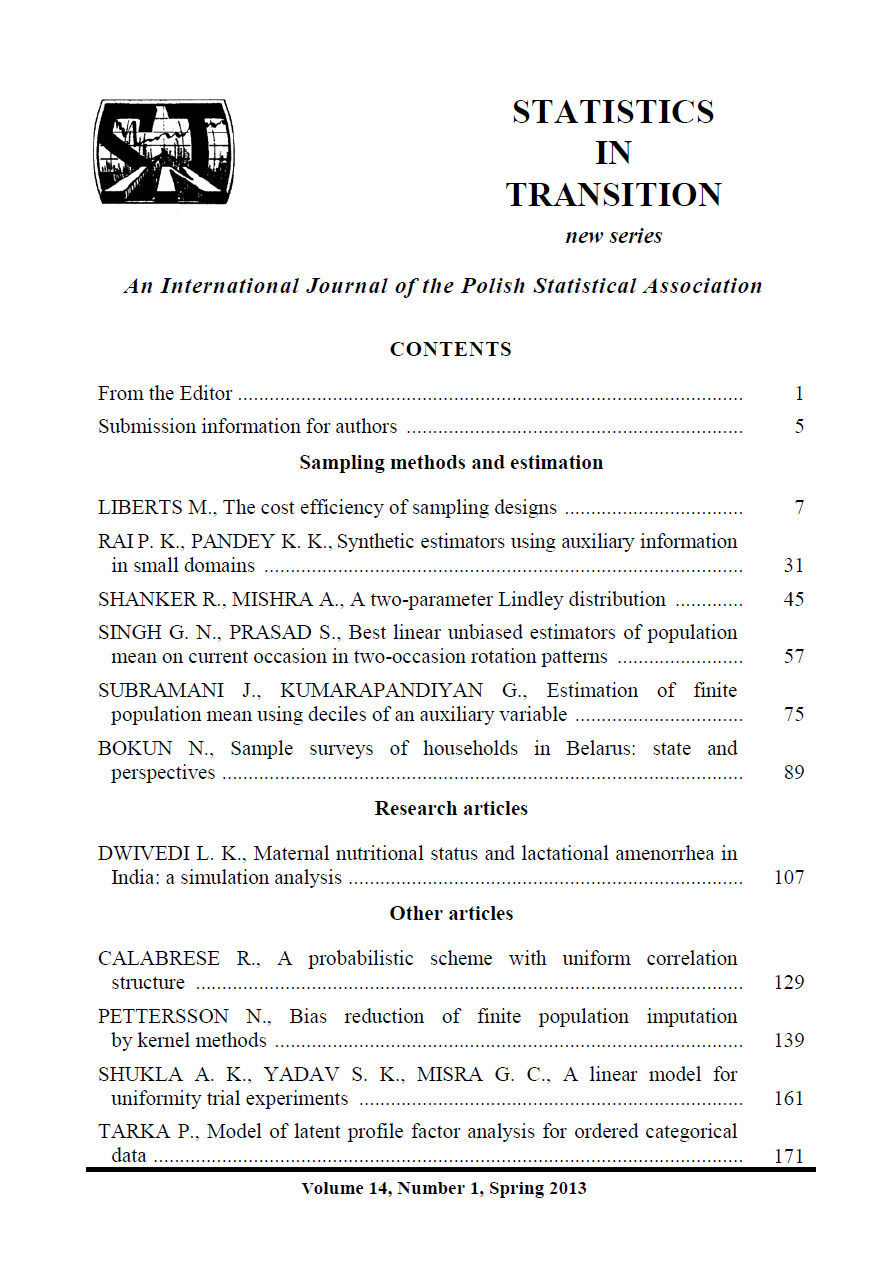ARTICLE
ABSTRACT
Apart from breast-feeding, socio-economic and biological factors, maternal health also influences the length or distribution of waiting time to conception. The main objective of this paper is to examine the linkages between maternal nutritional status (measured by body mass index-BMI) and postpartum amenorrhea among currently breast-feeding women in India and its region. Further, the probability to remain amenorrheic through simulative approach has been estimated to get better understanding of the impact of maternal nutritional status on postpartum amenorrhea. Using National Family Health Survey-2 data, women who were not pregnant, who were breast-feeding and who were not using any hormonal contraceptives at the time of the survey were included in the analysis. Missing cases for body mass index and child nutritional status were imputed by fitting the linear regression equation. There was no significant difference existing between mean BMI of each region of India before and after imputation of missing cases. The interaction term between maternal nutritional status and duration of breast-feeding (child’s age) was significantly associated with the likelihood of having resumed menstruation after controlling for breast-feeding practices, child nutritional status and socio-economic and demographic covariates. The effect of maternal nutritional status on lactational amenorrhea was not found to be significant when women were breast-feeding since last 12 months except in the northern region of India. However, after 12 months of breast-feeding, the probability of undernourished women to remain amenorrheic was likely to be greater and this trend was highly consistent across all the six regions included in the analysis.
KEYWORDS
simulative approach, maternal nutritional status, body mass index, postpartum amenorrhea, India
REFERENCES
CLELAND, J. G., ATHAR, Z. A., (1984). The Effect of Birth Spacing on Childhood Mortality in Pakistan, Population Studies, 38 (3): 401–418.
DELGADO, H. L., MARTORELL, R., KLEIN, R. E., (1982). Nutrition, Lactation, and Birth Interval Components in Rural Guatemala, American Journal of Clinical Nutrition, 35: 1468–1476.
DEWEY, K. G., COHEN, R. J., RIVERA, L. L., CANAHUATI, J., BROWN, K. H., (1997). Effect of Age at Introduction of Complementary Foods to Breastfed Infants on Duration of Lactational Amenorrhea in Honduran Women, American Journal of Clinical Nutrition, 65: 1403–1409.
DIAZ, S., RODRIQUEZ, G., MARSHALL, G., DEL, P. G., CASADO, M.E., MIRANDA, P., SCHIAPPACASSE V., CROXATTO, H. B., (1988).Breastfeeding Pattern and the Duration of Lactational Amenorrhea in Urban Chilean Women, Contraception, 38 (1): 37–51.
DWIVEDI, L. K., (2006). Contraceptive Use in India: A Multivariate Decomposition and Related Simulation Analysis, Demography India, 35(2): 291–302.
DWIVEDI, L. K., RAM, F., RESHMI, R. S., (2007). An Approach to Understanding Change in Contraceptive Behaviour in India, GENUS, LXIII (3-4): 19–54.
FRISCH, R. E., (1983). Population, Nutrition and Fecundity, In Malthus: Past and Present: Dupaquier, J (Eds.), A Fauve-Chamoux, and Grebinik, E, Academic Press, London: 393–404.
FRISCH, R. E., MCARTHUR, J. W., (1974). Menstrual Cycles: Fatness as a Determinant of Minimum Weight for Height Necessary for their Maintenance or Onset, Science (Wash. DC), 185(4155): 949–951.
FRISCH, R. E., REVELLE, R., COOK, S., (1973). Components of the ‘Critical’ Weight at Menarche and at Initiation of the Adolescent Spurt: Estimated Total Water, Lean Body Mass and Fat, Human Biology, 45: 469–483.
FRÜBECK, G., (1997). Leptin involvement in reproductive performance, Journal of Nutrition, 127: 1533.
GOURNIS, E., MCGUIRE, M. K., RASMUSSEN, K. M., (1997). Food supplementation during lactation shortens anestrus and elevates gonadotropins in rats, Journal of Nutrition, 127: 785–790.
HUFFMAN, S. L., FORD, K., ALLEN, H. A., STREBLE, P., (1987). Nutrition and Fertility in Bangladesh: Breastfeeding and Postpartum Amenorrhoea, Population Studies, 41(3): 447–462.
INTERNATIONAL INSTITUTE FOR POPULATION SCIENCES (IIPS), ORC MACRO., (2000). National Family Health Survey (NFHS-2), 1998–1999.India. Mumbai: IIPS.
KOPP, W., BLUM, W. F., VON PRITTWITZ, S., ZIEGLER, A., LUBBERT, H., EMONS, G., HERZOG, W., HERPERTZ, S., DETER, H.C., REMSCMIDT, H, HEBERBRAND, J., (1997). Low Leptin Levels Predict Amenorrhea in Underweight and Eating Disordered Females. Mol. Psychiatry 2: 335–340.
KURZ, K. M., HABICHT, J. P., RASMUSSEN, K. M., SCHWAGER, S. J.,(1993). Effects of Maternal Nutritional Status and Maternal Energy Supplementation on Length of Postpartum Amenorrhea among Guatemalan Women, American Journal of Clinical Nutrition, 58: 636–642.
LOUDON, A. S. I., MCNEILLY, A. S., MILNE, J. A., (1983). Nutrition and Lactational Control of Fertility in Red Deer, Nature (London), 302: 145–147.
LUNN, P. G., AUSTIN, S., PRENTICE, A. M., WHITEHEAD, R. G., (1984).The Effect of Improved Nutrition on Plasma Prolactin Concentrations and Postpartum Infertility in Lactating Gambian Women, American Journal of Clinical Nutrition, 39: 227–235
